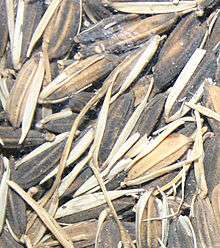Milling yield
Milling yield is a general term that can refer to the milling of any cereal crop.
Wheat milling yield refers to the percent of flour obtained from a given unit of whole wheat kernels (flour yield or flour extraction rate), averaging 70-75% in the United States.
Rice milling yield refers to the amount of polished white rice obtained from husked rough rice (yields of brown rice are higher). Rice milling rates for polished white rice vary by crop variety and quality, but tend to average about 72% of rough rice weight in the United States. Byproducts from rice milling include rice hulls (about 20% of rough rice weight), broken rice. and, for white rice, rice bran, polish, and rice germ (about 8%).
-

African rice in its inedible husk
-

The same rice, dehusked (whole brown rice)
-

The same rice, with almost all the bran and germ removed to make white rice
References
 This article incorporates public domain material from the Congressional Research Service document "Report for Congress: Agriculture: A Glossary of Terms, Programs, and Laws, 2005 Edition" by Jasper Womach.
This article incorporates public domain material from the Congressional Research Service document "Report for Congress: Agriculture: A Glossary of Terms, Programs, and Laws, 2005 Edition" by Jasper Womach.